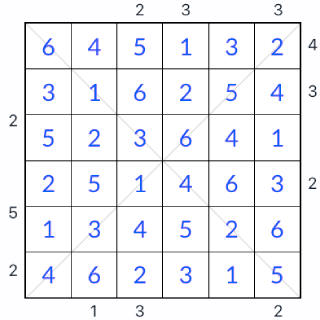Diagonal Consecutive Sudoku Easy
Like this puzzle!
4
7
8
1
2
6
7
8
5
3
6
6
2
3
1
8
5
4
7
2
8
7
4
5
2
1
9
8
7
7
9
3
2
1
4
3
1
5
9
1
2
3
4
5
6
7
8
9
?
~
123
1
2
3
Helping solve
Undo
Redo
Delete
0
Hint
Latest score list for #lx88d
be
betting 刚刚
5'33''
gu
guest 19分钟前
7'50''
so
social 10分钟前
19'16''
gu
guest 11分钟前
9'23''
an
anonymous 25分钟前
5'8''
li
lightroom 一小时前
6'30''
Au
Automotive 一小时前
9'57''
Pa
Paintless 一小时前
7'49''
an
anonymous 一小时前
8'45''
yo
youtube 一小时前
15'15''
Latest score list for Diagonal Consecutive Sudoku
an
anonymous solved puzzle No#mn1e2;
8'29''
gu
guest solved puzzle No#yvq2p;
15'39''
gu
guest solved puzzle No#xzvnd;
16'59''
gu
guest solved puzzle No#v0eyd;
10'32''
in
insurance solved puzzle No#jej7e;
10'38''
gu
guest solved puzzle No#7jjm1;
13'18''
bu
business solved puzzle No#828n4;
13'53''
yo
youtube solved puzzle No#mnryq;
17'1''
Ab
Abigail solved puzzle No#g4rx1;
4'23''
gu
guest solved puzzle No#kdpv2;
8'26''
How to play Diagonal Consecutive Sudoku
Diagonal Consecutive Sudoku Rules
Consecutive Sudoku: Standard Sudoku rules apply (1-9 in each row, column, and box) with the added twist of bars between some squares. These bars mean the numbers in those squares must be consecutive (differ by 1).
Diagonal Consecutive Sudoku Additional Rules:
-
Diagonal Sudoku Rule: Sudoku main diagonals also contain the digits 1 through 9.
Read more: Diagonal Consecutive Sudoku rule & tips
Using the Markings:
Pay close attention to the consecutive markers while placing numbers. If two cells are connected by a bar, the numbers you place in them must differ by exactly 1.
Conversely, if there's no marking between two cells, the numbers in those cells cannot be consecutive.
Diagonal Consecutive Sudoku = Diagonal Sudoku + Consecutive Sudoku.
Privacy Policy Copyright Gridpuzzle © 2024



























